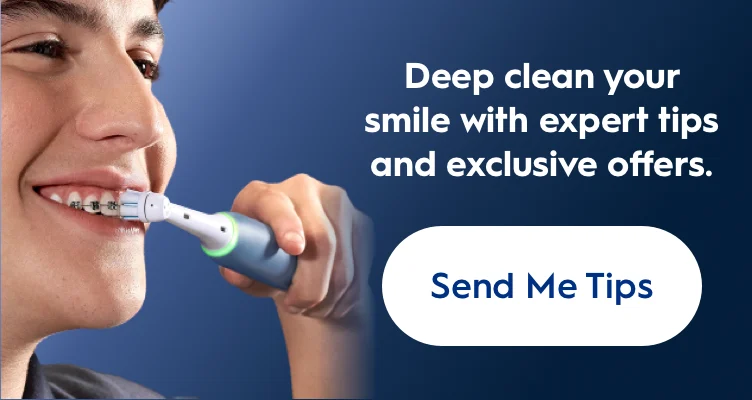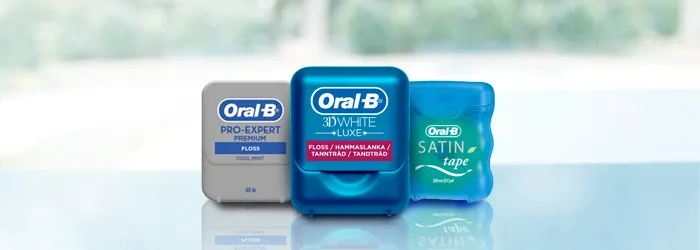
If your child needs or already has braces, take heart. Before you know it, they'll be flashing a confident smile if they keep these few things in mind.
For children with braces, looking after their own teeth and gums is even more important than ever. That's because in-between braces are tiny spaces where food particles and plaque get trapped. Insufficient cleaning can cause the teeth to stain and tooth decay to develop around the orthodontic brackets or bands.
Your child should brush carefully after every meal with fluoride toothpaste, containing 1350-1500 ppm, and a soft-bristled toothbrush. They should use a specialized, small-tufted interdental brush to clean between braces and under wires.
How to Take Care of Braces
The following points will help make your child's daily brushing routine effective:
Before brushing - Your child should take off elastics and any other removable parts of their orthodontic appliance. For removable appliances, take them out after every meal for cleaning.
Brush teeth - They should clean each tooth individually. First, they should place their brush at a 45-degree angle from the gum line, then apply gentle pressure whilst moving in a circular motion. They should do this for about 10 seconds, using the same brushing action on all outer and inner tooth surfaces, and tilting the brush as needed to better reach the insides of smaller front teeth.
Clean the braces - Your child should hold the brush at a 45-degree angle to clean around the wires and brackets of their braces. They need to brush from the top of each wire down to the bottom. They should take the time to ensure that all plaque and debris is removed, and that they work all the way around upper and lower teeth. For removable braces, clean them over a sink filled with water. This helps to prevent damage to the brace if you accidentally drop it. Brush the brace with a toothbrush and fluoride toothpaste to remove all food and debris. Be careful not to damage the wires. Once it's clean, put the brace back in the mouth.
Interdental brushes once a day - Have their dental professional show them the best way to clean between the teeth and braces. Also, they should follow the instructions on the product package. They may also want to use an interdental product designed for braces and orthodontic work, like a single-tufted toothbrush or floss.
Protecting your child's teeth – Braces put their teeth at greater risk of developing decay, therefore they need to keep their teeth strong by using fluoride toothpaste, containing 1350-1500 ppm. Brushing should be undertaken twice a day at a minimum and preferably after every meal.
If their dentist or orthodontist feels they are at greater risk of tooth decay, they may increase the fluoride concentration by (i) prescribing a stronger toothpaste (such as one containing 2800 ppm fluoride), (ii) applying fluoride varnish to their teeth two to four times a year when they visit them or (iii) asking them to use a fluoride mouthwash at a different time than tooth brushing.
Spit, but do not rinse after brushing – Rinsing after brushing will wash away the fluoride toothpaste which is needed to strengthen their teeth. This dilution effect is why even a mouthwash straight after brushing is bad news as it dilutes the fluoride around their teeth.
Keep up regular visits with their dentist and orthodontist.
Remind them to take care with what they eat and drink - It is inadvisable to eat very hard products, such as nuts or hard or sticky sweets, such as fudges or toffee. It is also important to limit sugary foods and drinks. Help them set up a food schedule to keep their teeth healthy. A good example is 3 meals, 2 healthy snacks a day, and only water or milk in between. They should watch out for foods with hidden sugars. Find out more about what foods are best for your child's teeth.
Discolouration of the braces – Your child should also remember that the elements of braces on teeth (the so-called ligatures) may become stained. That’s why they should avoid eating foods containing strong colourants, such as beetroots, blackcurrants, berries, curry sauce, or grape juice.
Plan Regular Check-ups
During the time that your child has braces on their teeth, they will need to visit the orthodontist regularly for adjustments to their appliance. After a routine orthodontic adjustment, they may experience some tightness or even some pain. Regular painkillers, such as paracetamol and ibuprofen, are effective at reducing this pain. However, if the discomfort or pain does not quickly dissipate after a few days, or becomes extreme, you should consult your child's orthodontist. Concerns about their appliances and any problems with broken parts should also be brought to your child's orthodontist's attention immediately.
It’s also important that your child continues regular visits to their general dentist whilst undergoing orthodontic treatment. Routine checkups are necessary to spot the early signs of tooth decay and gum disease. Their dentist or hygienist may also perform regular fluoride applications to provide additional protection to tooth surfaces from tooth decay whilst they're wearing braces. Your child's home oral care techniques will be monitored by their dental professional and changes will be recommended as necessary. As always, they should be sure to follow their instructions.
A View From the Expert
Ewa Iwanicka-Grzegorek M.D., Ph.D.: “Teeth during orthodontic treatment are especially prone to decay and gum inflammation. This situation occurs because dental plaque often covers the metal parts of the braces and builds up in the areas which are difficult to reach.
If dental plaque is not removed regularly, it can lead to tooth and gum problems. If left, plaque can harden and can only be removed by your dental professional. I always try to explain to my patients who wear braces that daily, thorough cleaning of the mouth is absolutely essential.
I recommend brushing teeth with an electric toothbrush incorporating oscillating-rotating technology, which removes twice as much plaque as a manual toothbrush. There are special products which can be used to improve oral care for teeth with braces during orthodontic treatment. Among others: a tip for electric toothbrushes, interdental toothbrushes for cleaning the spaces between the braces, single-tufted toothbrushes or floss. Ask your orthodontist on how best to keep your braces clean.
Apart from regular appointments with the orthodontist, the patient wearing braces should have regular check-up appointment with the dentist."
Related Articles
Sign Up
for expert advice and exclusive offers








